|
|
|
FES
October 12, 2009
The train trip to Fes, about 3 hours going south,
took us through a greener countryside. Planted orchards and vineyards covered
the rolling hills. Through the distance haze we could see the mountains.
As we neared Fes, we were visited by a number of Moroccans trying to befriend us
to be our tour guide or invite us to their "friend's" Riad. We had already made
arrangements to stay at the small Sakaya Pension for 300 dirham/night (30 eu),
right in the Medina.
On the train, we met up with fellow cruisers from the
American Traveller, also traveling to Fes. We stepped off
the train into a city with an entirely different feel to it than that of
Marrakesh.
The legendary Moroccan city of Fes (also spelled Fez)
was
founded in the 9th century and home to one of
the oldest universities in the world. Fes reached its height in the 13th and
14th centuries, when it replaced Marrakesh as the capital of the kingdom.
The political capital of Morocco was transferred to Rabat in 1912.
The fortification walls around Fez date to the
11th century having been restored with traditional mud, made of sand and
lime. Its principal mosque is the holiest in the
country and governs the timing of Ramadan and other Islamic festivals.
We shared a large taxi with Traveler to the centre of
the Medina. There are two types of taxis in Morocco, the larger more
expensive Mercedes and the battered run down smaller blue painted cars called
Petit Taxis, much cheaper but sometimes barely road worthy.
|
|
 |
Someone from our Riat was sent to show us the way
and, since Traveler did not have any accommodation booked,
came with us to see if they could also get a room.
A young man led us
through a series of twisty narrow streets, turning one way and then another
until we were sure we would never find or way out of the maze. Our room was basic,
decorated about as tacky as it gets. But it had the most elaborate door
imaginable. Carved and painted with decorative motif. The bathroom was not all
that clean so we used a plastic bag to stand on while showering. The price
included breakfast, which was coffee and a round of bread with marmalade
(typical Moroccan pension breakfast). The people were very friendly and we
enjoyed our accommodations. |
 |
|
Since there were
no vacancies at the Sakaya Pension, we decided it might be
interesting to follow the search for accommodation in the Medina. We wandered down the cobblestone alleyways until we found a tiny sign
advertising "hotel" or "room" or "riad" over a non-descript doorway, usually in a dirty high
stained cement wall in a constricted passageway. Normally the riads are more expensive than the
pensions, but some are still a bargain and our friends were hoping to find one
of these. Many of the riads were rooms let out in people's homes making
the experience interesting. It was a treat to see the inside of these
places, which looked so dreary from the outside. But once inside, it was
another world. The central courtyards opened to the sky. Around the
courtyard, levels with rooms, windowless except for the doorways out to
the balconies overlooking the courtyard. The walls and doorways were
elaborately carved wood and painted plaster with intricate details. Soon
there was a gathering of many local boys offering to guide
Traveller around to various other options. |
|
Finally, our
friends settled for a place so our "tour" of riads came to an end. We all went
for lunch at an outside cafe near the Blue Gates and a local boy played the
bongo drums for us while we visited. It was a great people watching spot, older
Muslim women strolling by in their full burkes and veils, while the younger
Muslim women wore colorful headscarves
with fashionable clothing overtop of leggings or long sleeved shirts. And there
was the steady stream of donkeys packing their loads, the colorfully dressed
"Waterman" selling cups of water, beggars, children, performers in the
streets. |
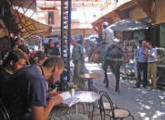 |
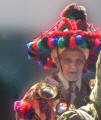 |
 |
|
We made our way to the
Blue Gate, the
main entrance into the Medina and the main part of the walled city.
The Blue Gate was currently under repair but the blue Moroccan
tiling around the archway was impressive. |
 |
There
was a huge difference between the Arabs of Fes as compared to
Marrakesh.
In Fes, people were very
friendly and didn't want anything in return for helping. The shopkeepers were all happy to show
you their goods, but if you decided you were not interested, they didn't insist
or chase after you like they did in Marrakesh. Just "Thankyou for looking,
have a nice holiday." despite the shop keepers saying that the
tourists were not buying, and their families were suffering. Shows
how the western world's economic depression affects everyone.
The merchants were eager just to offer
mint tea,
to chat, to hear all
about our sailing
adventures from across
the ocean. |
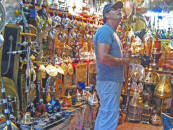 |
|
After lunch we struck out on our own and walked
around the Medina. The main area is laden with touristy shops, all competing to
sell many of the same items. We spent hours looking for something unique and
finally found it.
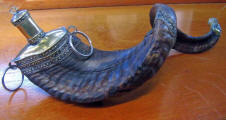
A twisty sheep's horn, inlaid and covered
with silver and a cap, once used to carry gunpowder. A conversation
piece for Chris' collection of artefacts!
|
Fez Pottery Many shops sold the famous Fez Pottery, many with inlaid
silver trim. The traditional Berber color is
blue. |
|
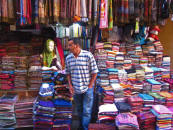 |
|
 |
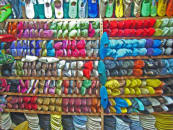 |
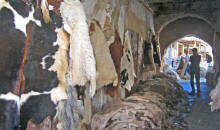 |
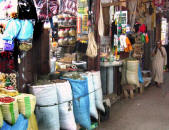 |
|
Slipper makers, Shoe sellers & Leathermakers |
hanging hides |
dried goods &
everything else |
 |
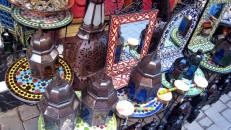 |
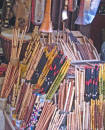 |
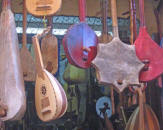 |
|
Fes Caps |
Moroccan tile and
mirrors |
Piles of Pipes |
unusual
musical instruments |
| I always love to visit the
produce market, with its scents of fresh fruit, mint and
cilantro, and colorful vegetables. The Marketplace in Fes was
bustling with activity and the roar of vendors shouting their
wares and locals haggling for their daily necessities. |
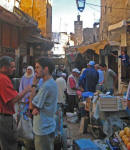 |
 |
 |
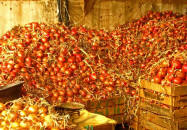 |
|
Huge
squash, crisp apples, bundles of greens, next to brooms & linens |
Oodles of Onions |
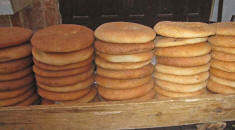 |
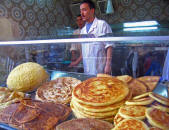 |
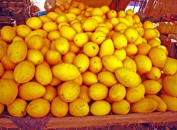 |
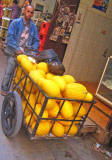 |
|
Flat breads piled high, usually
buzzing with flies. Wasps prefer the
sugary pastries and there was always a swarm of them
crawling over
anything sweet.
|
Mounds of Melons
We learned to identify the
"premier" melons as the ones with 3 red dots painted on them |
|
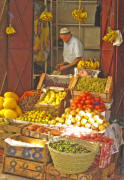 |
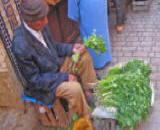 |
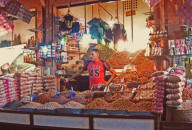 |
 |
Street stalls selling
stacks of boiled snails, to
be plucked from their brown-and-white
striped shells with safety pins. |
| Bundles of Fresh Cilantro |
Freshly
ground spices |
Snails! |
|
As we strolled along we would get a sudden whiff of
the unmistakable stench of fish and meat. The meat market area in
Morocco has a characteristic all to itself. Live chickens squawk on the butcher
block then their bodies twitch and pulsate. Cages of ducks, rabbits, and geese
await a similar fate. |
 |
 |
 |
Butchers were watched
by the ever present, ever hopeful profusion of
stray cats. |
|
Meat Market of a Different Sort
We strolled through the market with the
usual hanging meat but also with hanging sheep and camel
heads and legs with the hoof still on. And piles of
brains, liver, testicles and such, everything crawling
with flies.
Cow and sheep's feet are strung up, complete
with hooves. Goat and camel heads lay on display. |
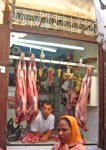 |
 |
 |
|
 Beyond the Souks and
Marketplace, into the
humid shadows of the labyrinth, constricted lanes led us through a tangle
of rough streets, winding, turning and intersecting with
other interesting paths. Beyond the Souks and
Marketplace, into the
humid shadows of the labyrinth, constricted lanes led us through a tangle
of rough streets, winding, turning and intersecting with
other interesting paths.
Here was the essence of
Moroccan life in Fes, men taking a moment from selling
their livestock to read a paper, men and donkeys packing
loads, men in gowns sipping mint tea, some just
sleeping! |
 |
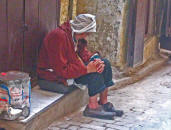 |
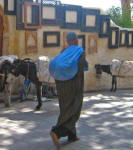 |
|
 |
Continuing along, we meandered down the jumble of streets, moving aside for men
pushing carts or donkeys laden to the max with heavy loads. And everywhere
DONKEYS. Some melancholic, some patient. You always had to watch where you
stepped. Nowhere have we ever seen donkeys used as much. They carried burdens
down the streets, far too narrow for any vehicle. Some alleys had a low dropped
overhead block to prevent the donkeys from traveling down those streets.
Some
of the loads the donkeys carried were unimaginable. Click here to see The Donkey, Beasts of Burden Page. |
 |
|
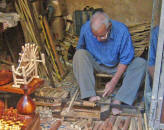
|
Tucked
away in inconspicuous nooks were cramped quarters
where tradesmen toiled. Carpenters creating items
from the local cedar root using a hand made lathe powered
by foot, women stringing beads of coral and amber,
craftsmen carving pipes and haircombs from bone and
horns, tailors labouring
over their Singer treadle machines in dark corners,
leather makers cutting belts. |
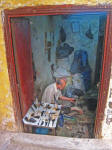
|
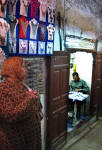 |
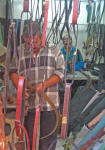 |
|
Woodworker |
Bone Carver |
Tailor |
Belt Maker |
|
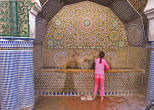 |
 |
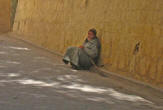 |
 |
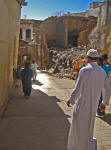 |
|
Muslim water
fountains |
Canal running through Fes |
Beggars in
the streets |
|
Old, haggard,
red eyed Beggars search passer-bys with outstretched hands and pleading face.
|
|
 Strong Islam Faith Strong Islam FaithWe passed many elaborate
Mosques but were only permitted to peak in the
carved entrances to the majestic tiled pillars inside. Non Muslims are not
allowed inside. We could see the luxuriously intricate engraved stucco ornamented
walls with glazed tile, carved and painted wooden arches, marble columns, highly
delicate and almost lace-like. A
mosque in Fez was the
center of a neighborhood complex usually
consisting of a fountain, a msid (Koranic school for children), public toilet,
hammam (public bath), and bakery.left: Koutoubia Mosque, constructed in the 12th
century |
|
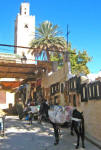 |
|
 |
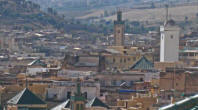 |
We
started to climb the hills going away from the
main part of the Medina and soon reached a
beautiful vantage point where there was a view
of the entire city. The triangular shaped roofs,
minarets, stained cement tenements and twisty
alleys. |
 |
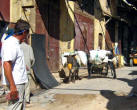 |
Lost in the Medina
I think anyone who has
been to Fes has gotten
lost in the Medina! We
were so mesmerized by
all the sights it was
soon dark and we had
wondered far off the
beaten track. We
realized that we were
hopelessly lost at the
edge of the walled
Medina. We were
wandering around in an
attempt to find a road
in the right direction
when a young boy warned
us not to go down the
street we were preparing
to turn onto. He said it
was dangerous and we
should go in a different
direction. |
 |
|
At this point a
Moroccan
girl, named Bahia, came to our assistance. She spoke English and offered to lead
us back to the Medina, which was a fare distance away. So along with her little
sister, Donia, we chatted as she led us down the labyrinth of alleyways and
cobblestone streets back to a spot we recognized. She told us there was much
crime in Fes and we were glad of her help as many of the shops were closed and
the streets were empty. All she asked in return was our email address.
|
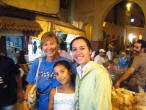 |
|
We had supper at the
Clock Cafe, little tables set on various levels of
the roof near the Water Clock tower offering camel burgers and genuine
Moroccan food. |
|
|